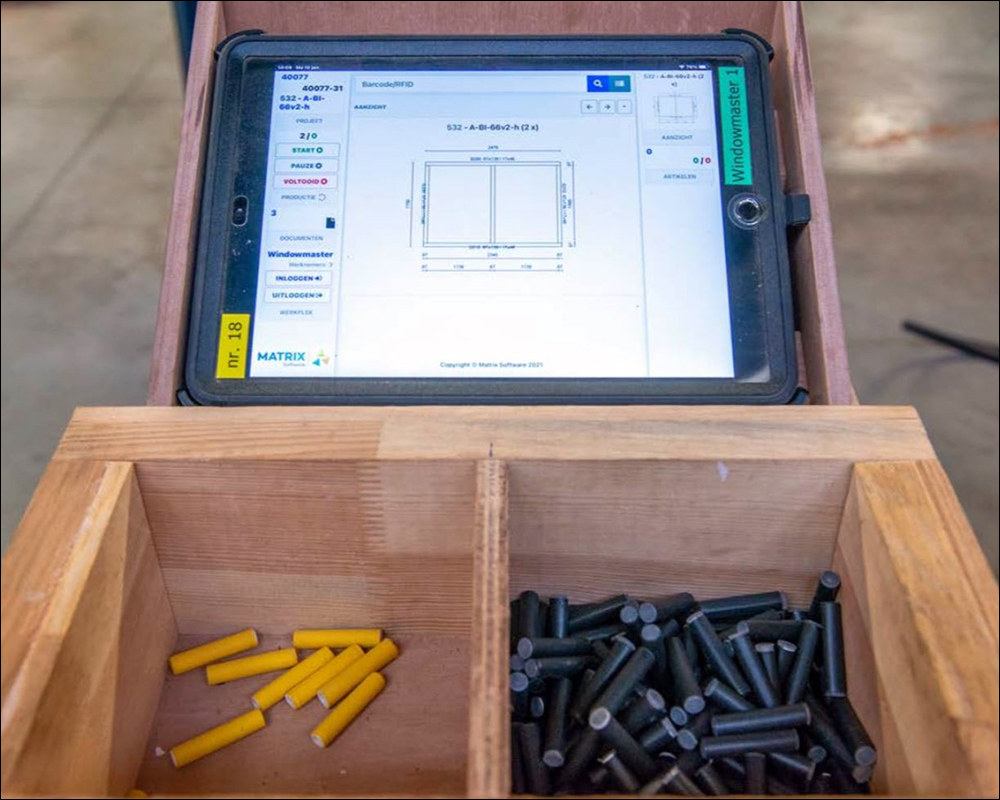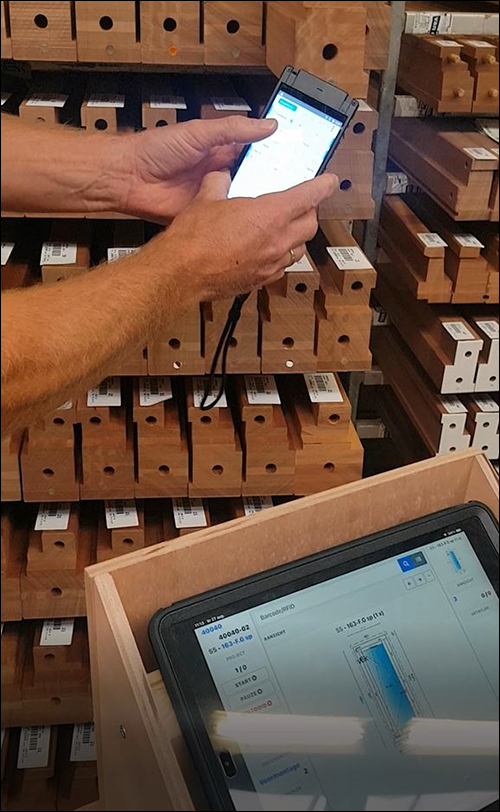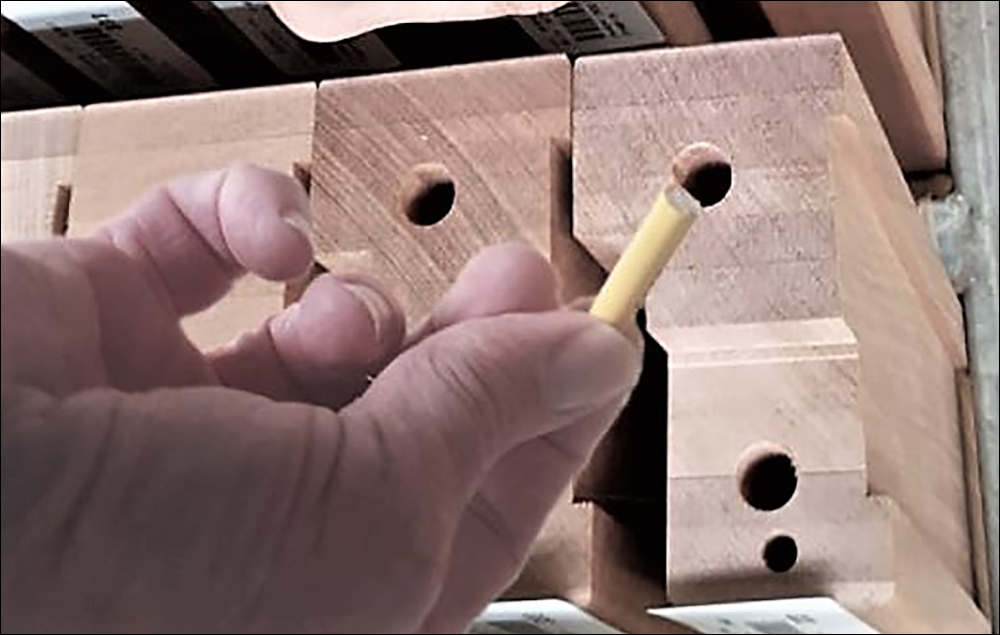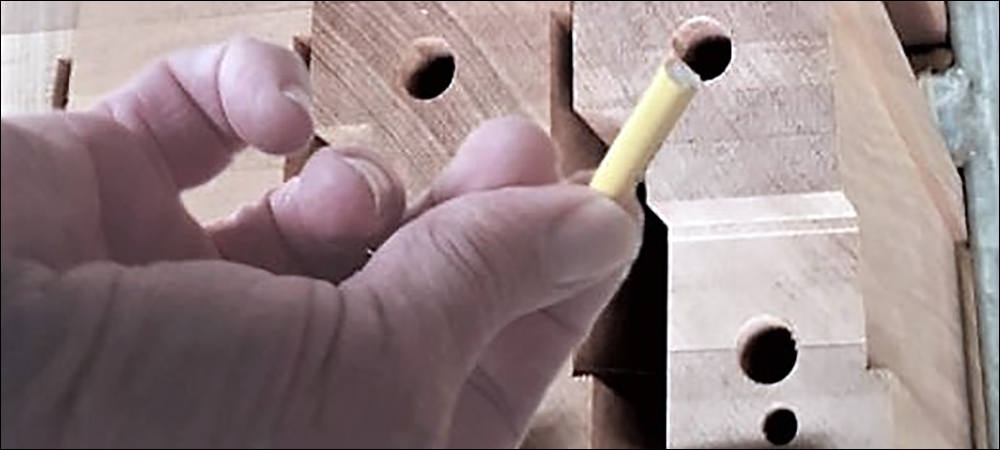- Dowel-Shaped Tag Built for Wood
- Capturing Work-in-Progress via RFID
- Saving Thousands of Euros Annually
When builders and homeowners require custom-made windows and frames, they typically have little room for delays. With that in mind, Van de Vin recently deployed an RFID-based solution to track its custom wooden window frames as they move through production. The result, according to the company, has been a reduction in costs related to manually tracking orders and products on paper, the identification and prevention of errors, and an improvement in efficiency. The automated system leverages passive UHF RFID technology from U.K.- and Germany-based RFIDdirect, developed to operate reliably in the highly challenging environment of wood product assembly.
The company’s Timber UHF RFID Dowel tags are inserted into the end of each plank of wood, then are read at eight workstations via fixed readers embedded in the floor. Van de Vin’s manufacturing execution system (MES), provided by Matrix Software, manages the collected RFID read data and provides real-time updates and alerts based on production activities, as well as instructions for workers at each station on the production floor, specific to every frame. The solution was taken live at the end of 2021, and it has reportedly boosted the company’s efficiency and reduced its risk of errors.

Van de Vin manufactures wooden frames for the construction and renovation of houses and apartments. Its custom-made frames, produced in the Dutch town of Heeze, are sold as semi-finished products, or they can be sold ready to install—lacquered, glazed and prepared for the building for which they are destined. The tracking of orders can be a challenging task. Traditionally, the company used paper to manage orders manually, as well as a barcode sticker on each frame that could be scanned to identify a frame up to the point at which it was painted.
The company tried engraving the frame on the processing line with a unique ID number, but the identifier required that someone look up the engraved serial number, which proved cumbersome. To gain visibility with less manual intervention, Van de Vin sought a way to automatically track each wooden plank used in the manufacturing of frames. But although RFID provides that automatic tracking functionality, it was a technological challenge for the woodworking company, according to Rudolph Den Boer, Van de Vin’s IT manager. RFID does not inherently transmit well in and around wood, he says, since timber is dense, with a high volume of liquid that obstructs RF signals.
Dowel-Shaped Tag Built for Wood
 The company had investigated RFID, Den Boer says, but found that the technology came up short of its expectations. The management “just played with access-control systems,” he recalls, “which proved to be inadequate for the product traceability.” Additionally, any identifier had to be long-lived—as much as 75 years, the frame’s typical lifespan. The company took its challenge to RFIDdirect, which conducted its own field tests and suggested how to deploy the RFID tags. “They wanted to identify the individual products” to measure delivery performance and capture work-in-progress details, recalls Mohssine Ouchen, RFIDdirect’s business-development manager.
The company had investigated RFID, Den Boer says, but found that the technology came up short of its expectations. The management “just played with access-control systems,” he recalls, “which proved to be inadequate for the product traceability.” Additionally, any identifier had to be long-lived—as much as 75 years, the frame’s typical lifespan. The company took its challenge to RFIDdirect, which conducted its own field tests and suggested how to deploy the RFID tags. “They wanted to identify the individual products” to measure delivery performance and capture work-in-progress details, recalls Mohssine Ouchen, RFIDdirect’s business-development manager.
The project took time to develop, according to Frits van Calker, RFIDdirect’s managing director. The company was familiar with the challenge, he says, and had conducted some academic research on the subject. It began with a master’s student from École Supérieure du Bois, an engineering college in Nants, France, to understand the chemical and mechanical behavior of timber. The result was published by Bangor University as an academic article.
RFIDdirect conducted a further study for two years with three students from West Chester University, in the United Kingdom, to understand in more detail the electro-magnetic behavior of RFID embedded in timber. Beyond that, the installation is another challenge, so the company had to produce a label that could be drilled inside timber. RFID has not been adopted at a wide scale in the wood carpentry sector, van Calker says, in part because of these challenges.
For Van de Vin’s deployment, the tag is designed to account for disturbances in the backscatter signal. The company developed a dowel-shaped tag principle, van Calker says, which “was the preferred formfactor, though this is not perfect for RFID chipset antennas.” The dowel-shaped tag comes with a plastic casing to provide protection for humidity and pressure, and the company needed to drill a hole and insert the dowel with a built-in RFID chip. Testing found the tag worked well in this environment, he adds, and that it could be read from a distance of around 2 to 4 meters (6.6 to 13.1 feet).
Capturing Work-in-Progress via RFID
As the beams of windows frames come out of a robotic production machine, a hole 50 millimeters (2 inches) deep and 8 millimeters (0.3 inch) wide is drilled to accommodate the RFID tag. RFIDdirect built reader stations with Denso Wave barcode scanners and Impinj R700 RFID readers, along with one set of antennas at each station’s entrance and a second at the exit point, embedded in the floor. Impinj’s middleware accomplishes the barcode link to the RFID tag ID, while also controlling light indicators for operators.
When a tagged frame arrives at a station, the RFID reader captures the tag ID and forwards that data to the Matrix software, which updates the product’s status. A worker at the station uses a touchscreen to view information regarding that product, and the software displays the assembly requirements for that specific frame. For instance, the software indicates what size and type of glass goes in the window, before it moves to another station for painting, quality control and packaging. After the product is shipped out, the tag goes with it and can be used for identification purposes, in the event of maintenance or warrantee issues.
The company employs handheld RFID readers to locate specific frames in the event of an exception, or if workers are seeking its location and status. In addition, the software stores a record of every read that takes place at the workstations, linked to the process completed at each station, as well as when a delay occurs. Since the system was taken live, the technology has reduced the number of faulty products based on assembly errors, while also boosting production speed, and the company can now respond to customer requests related to the status of a specific order, by viewing that data in the software.

Saving Thousands of Euros Annually
When it used paperwork to manually track orders, the company says it paid around €30,000 ($29,150) a year, which means the system saves Van de Vin that cost. That’s because workers no long need to print paper job cards, paper drawings of the frames or instructions. Additionally, Den Boer says, the technology has allowed Van de Vin to eliminate product searches as visibility improved via the software, saving about €18,000 ($17,490) annually.
“The software was critical in this process,” Den Boer states. “Now [that] the system is operational and all team members understand the boundaries, there are no problems anymore.” One early challenge for Van de Vin was to gain a seamless process for commissioning new tags. It needed the ability to scan timber barcode labels, and to match such serial numbers with the RFID tag ID numbers in the software, in a single scanning movement. “This is solved by the design and delivery of a bespoke scanning unit by RFIDdirect.”
In the long term, Van de Vin hopes to use the RFID tags to provide each frame with a lifelong product passport. In that way, it could provide traceability of products after sales, storing maintenance historical information and preventive maintenance management. Beyond that, the tags could be used during a frame’s disposal. Those with RFID readers could scan a frame’s tag in the field or during scrappage or rebuilding, enabling them to contribute to a circular economy and improve sustainability.
Key Takeaways
- RFIDdirect is providing Van de Vin with an RFID system that works well in the highly challenging environment of timber and wooden frames.
- With the technology in place, the company knows the status and location of every frame during production, while the RFID data could provide a life history all the way to disposal.


